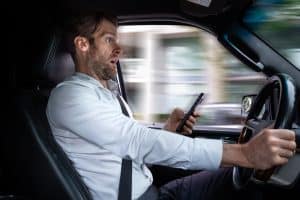How Do You Prove a Distracted Driver Caused an Accident?
 You’re driving along the road when suddenly – bam – a distracted driver hits you, causing an accident and injuries. When distracted drivers cause accidents, whether by taking their minds or eyes off the road or their hands off the wheel, they should be held accountable for the resulting damages.
You’re driving along the road when suddenly – bam – a distracted driver hits you, causing an accident and injuries. When distracted drivers cause accidents, whether by taking their minds or eyes off the road or their hands off the wheel, they should be held accountable for the resulting damages.
However, establishing that the driver who collided with you was distracted is not always straightforward. You may suspect the other driver was distracted, but the hard part is proving it. A dedicated Boston car accident attorney will explore all angles to help prove that your damages were caused by the other driver’s negligence.
What kinds of evidence are used to prove a driver was distracted?
There are several types of evidence that our attorneys can utilize to support your distracted driving accident claim:
- An admission of guilt: A driver may admit fault, sometimes immediately after the accident. For example, they might say, “I’m sorry! I was texting and didn’t see you!” Such admissions are typically included in the police report.
- Police report: Police officers in Boston are taught to recognize the signs of distracted driving, and may note how they believe the accident happened in their initial police report. While the report itself might not be admissible, the report will point to evidence that will be.
- Physical evidence: Inside the vehicle, evidence might include a recently used cell phone, an open book, open fast-food containers, a loud radio, and so forth. Roadside evidence may include tire tracks showing delayed braking, tire marks off the designated roadway, or obvious collision points at intersections where most drivers would yield. Finally, video from local surveillance cameras, dashcams, or even smart doorbells may provide footage that can be used to prove your claim.
- Eyewitness testimony: Eyewitness accounts are important in any claim of distracted driving. An eyewitness can testify to observing the defendant using their phone or engaging in other distracting behaviors. They may also have observed the driver wandering back and forth between lanes.
- Expert witness testimony: Professionals like accident reconstructionists can recreate the events, showing a jury just how the crash occurred. Data can be extracted from phones, too, so a digital forensics expert can testify to whether a driver was texting or speaking on the phone at the time.
- Phone records: Phone records can also help note that a person was driving while distracted, although your lawyer may need a subpoena to access these records. This can take some time, but is not impossible.
- Social media: If the other driver was on social media at the time of the accident, this activity should be timestamped and logged on the app. We can investigate to see whether the person who caused your accident was posting, uploading a picture or video, updating their status, or otherwise distracted.
Our attorneys do all we can to prove another driver was distracted and caused your accident, utilizing all the evidence available.
What is distracted driving?
The NHTSA defines distracted driving as “any activity that diverts attention from driving, including talking or texting on your phone, eating and drinking, talking to people in your vehicle, fiddling with the stereo, entertainment or navigation system — anything that takes your attention away from the task of safe driving.”
Over 3,500 people were killed in 2021 due to distracted driving. Texting and driving is one of the most risky forms of distracted driving, with the NHTSA noting that “Sending or reading a text takes your eyes off the road for 5 seconds. At 55 mph, that’s like driving the length of an entire football field with your eyes closed.”
What injuries are caused by distracted driving in Boston?
Distracted driving can lead to various types of injuries, including:
- Brain injuries: In more severe accidents, injuries ranging from concussions to traumatic brain injuries (TBIs) can occur, especially if the driver or passengers hit their heads on the dashboard, steering wheel, or windows.
- Spinal cord injuries: High-impact collisions may lead to spinal cord injuries, which can result in paralysis or other long-term disabilities.
- Broken bones and fractures: The force of a collision can cause bones to break or fracture, including arms, legs, ribs, and facial bones.
- Soft tissue injuries: Bruises, cuts, and strains to muscles, tendons, and ligaments are common in car accidents, particularly when sudden movements and stops occur.
- Internal injuries: Impact from a collision can cause internal injuries, such as damage to organs or internal bleeding, which may not be immediately apparent but can be life-threatening if left untreated.
- Whiplash and neck injuries: Sudden stops or collisions can cause the head to jerk forward or backward, resulting in whiplash and other neck injuries. Breakstone, White & Gluck once secured $2.2 million for a client who sustained such severe injuries from a distracted driver that he needed a spinal nerve simulator to achieve any relief from his pain.
- Emotional and psychological trauma: Being involved in a car accident, especially if it results in injuries or fatalities, can lead to emotional trauma, including anxiety, depression, and post-traumatic stress disorder (PTSD).
At Breakstone, White & Gluck, our Boston car accident attorneys fight for victims of distracted driving. You don’t have to worry about your case: let us handle everything for you. To schedule a free consultation, call our offices or fill out our contact form today. Proudly serving clients throughout Massachusetts.
